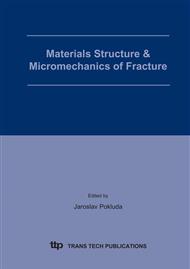p.251
p.255
p.259
p.263
p.267
p.271
p.275
p.279
p.283
Effect of Structure on Creep Behaviour of Superalloy Single Crystals
Abstract:
Creep behaviour of two types of superalloy single crystals of the orientation <001> was studied at 850 °C in air to assess their relative suitability for turbine blade applications: CMSX-4 and its potential low cost alternative, CM186LC. The chemical composition of these two superalloys is similar, their microstructure, especially g/g’ distribution, differs substantially. At the same applied stress, the time to failure of CM186LC is shorter than that of CMSX-4. Simultaneously, the creep rate of CM186LC is higher than that of CMSX-4 for the whole lifetime. This is attributed to easier activation of dislocation sources within large g’particles present in CM186LC crystals.
Info:
Periodical:
Pages:
267-270
Citation:
Online since:
April 2005
Authors:
Price:
Сopyright:
© 2005 Trans Tech Publications Ltd. All Rights Reserved
Share:
Citation:


